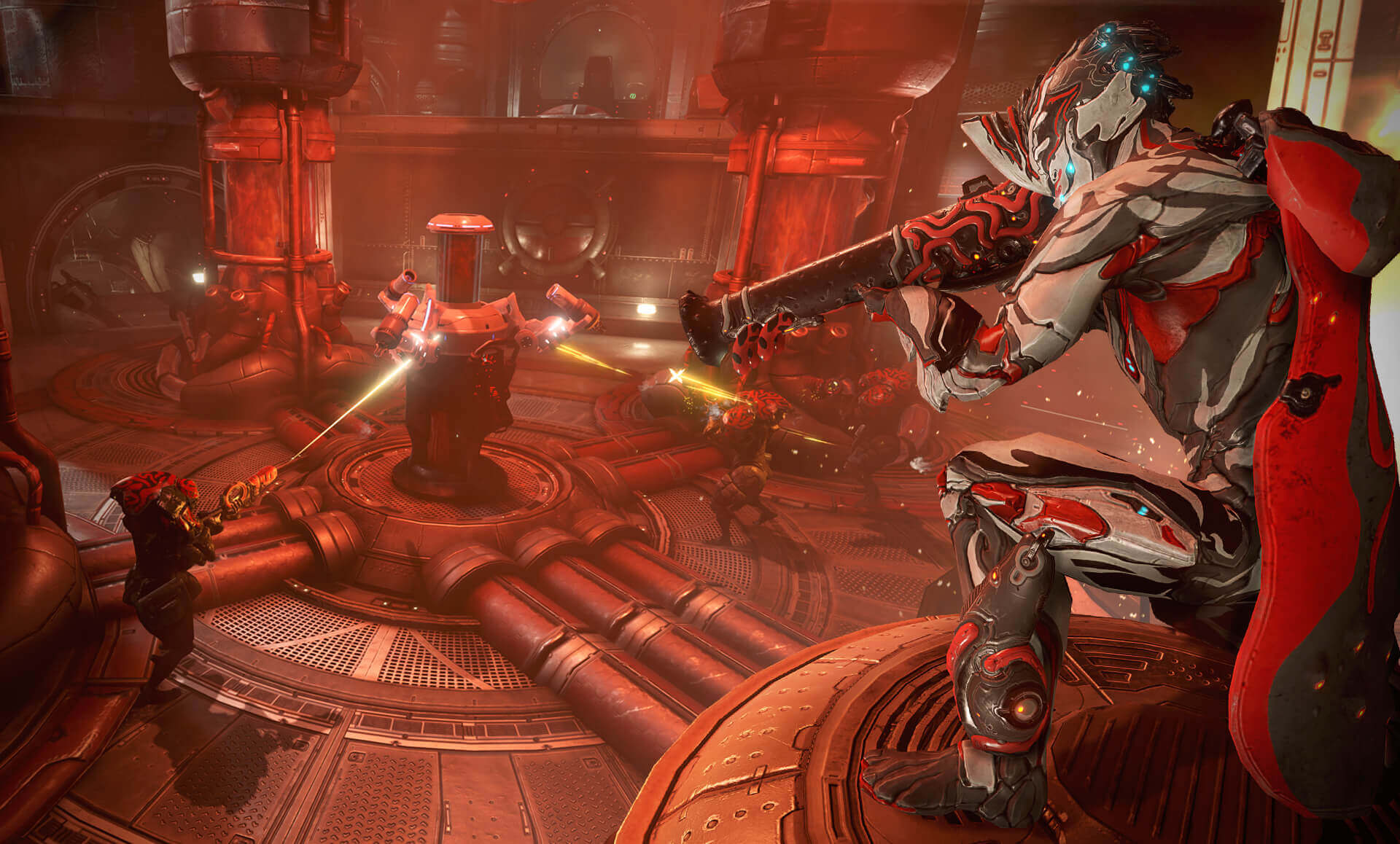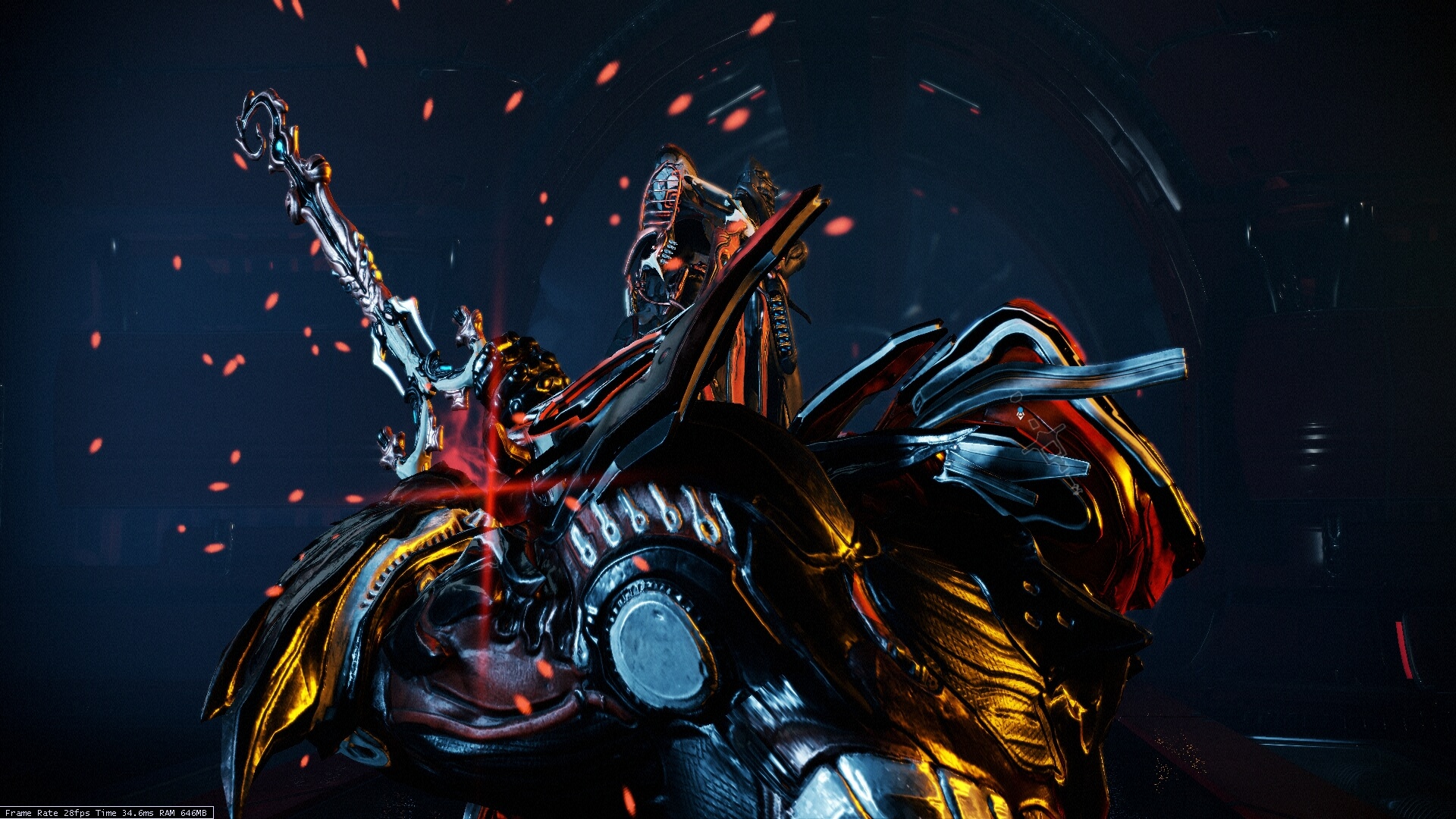It’s easy to fail in the video game business. If you sit still long enough, this ever-changing market will leave you behind. Someone with fresher ideas will happily step in to take your place. But that’s what makes the success of long-running studio Digital Extremes so fascinating — it has adapted and survived for nearly a quarter of a century, and its ideas aren’t growing stale.
Digital Extremes runs the popular free-to-play shooter Warframe for PlayStation 4, Xbox One, and PC, which has you controlling a cybernetic alien in various kinds of cooperative missions or in a competitive multiplayer mode. It debuted in 2013, and it has since grown both in terms of the kinds of content it offers as well as its number of active players. Warframe is now more popular than ever. With the launch of The War Within update in November, Warframe hit 68,530 concurrent players on the Steam PC gaming service, which was a new all-time high. Digital Extremes didn’t share that number for the game on consoles, but it is among the most downloaded games on PS4 and Xbox One. In November, it had more than 1 million monthly active users across all platforms.
Warframe’s ongoing growth is a sign that Digital Extremes is doing a lot of things right, but the studio isn’t following a predetermined roadmap. It has made its own way with Warframe from the beginning, and it has found a way to attract new players with regular, exciting updates while also retaining current fans by establishing a strong relationship with its community. That has enabled Digital Extremes to add elements like a fleshed out story and player-versus-player competitive modes without turning people off.
All we are saying is give Warframe a chance
Today, Warframe has a vocal and dedicated audience, and that’s something that publishers repeatedly told the studio would never happen. Digital Extremes vice president of publishing Meridith Braun told GamesBeat during a chat that no traditional publisher ever wanted Warframe. The studio started in 1993, and it spent the bulk of its time as a hired gun for other companies that needed help finishing or building content for their big-budget blockbusters.
But Digital Extremes always wanted to work on its own games, and it had the idea for Warframe and started shopping it around in an effort to secure financial support.

Above: Meridith Braun, vice president of publishing at Digital Extremes.
“We tried pitching Warframe as a different IP called Dark Sector about 10 years ago now,” said Braun. “Back when we were a work-for-hire studio, we were pitching around trying to get publisher money to help us fund a new IP. Dark Sector eventually got made, but nothing like what we originally thought it would be.”
Dark Sector, which was a third-person action adventure with cover-shooter elements came and went. Today, it is best remembered as one of the earliest “next gen” games revealed for the then secretive Xbox 360 and PlayStation 3 systems. After that release, Digital Extremes developed the shooter Darkness II and did port work on BioShock 2 and work-for-hire help on Halo 4.
But the company leadership was beginning to see that business model was beginning to fade away in 2010 and 2011.
“We were coming to a crossroads in the industry,” said Braun. “Mid-sized independent development teams like ours were becoming dinosaurs. Extinction was imminent. We were competing with $100 million games, and we were still only getting $15 million budgets.”
Digital Extremes chief executive and founder James Schmalz got the senior staff together to brainstorm about what to do next. It turns out that most of the team never forgot about the original idea for Warframe and wanted to find a way to make it into a game.
The studio was also thinking about this new free-to-play business model that was starting to take off thanks to games like League of Legends. They realized that it wasn’t all that different from some other business models that were popular in the early days of the studio.
“Digital Extremes started in the shareware days, so it wasn’t too different in our minds from what we used to create for shareware, where you give out a portion of the game for free, and if it’s good enough people will pay for the rest,” said Braun. “Modern-day free-to-play, the way it’s become, took a bit of a weird twist from the eastern side of things, where it squeezes the player, and the game gets left behind in terms of quality. We thought there was an opening where games could actually be of good quality, you could give them away for free, and in general people would do the right thing and choose to give back their money to something they believed in, that they enjoyed, that they got great entertainment from.”
Before deciding to self-publish the game, Digital Extremes took this new pitch back to a series of publishers, and they were told the idea wouldn’t work.
“They told us the game would fail because it was PVE [player-vs.-environment] and it was too sci-fi. No one was going to get it,” said Braun. “To survive in free-to-play land, they claimed, you needed to be first and foremost a [competitive] PVP game, and you needed to have some sort of relatable premise, which wasn’t science fiction.
“At that point, we decided, well, we’re going to do this on our own. No one’s going to talk us out of this again.”

Above: Dark Sector, Digital Extremes’ cover shooter for the PlayStation 3 and Xbox 360.
On its own … but not alone
When Warframe launched in early beta tests for PC in 2013, it was the PVE sci-fi game that Digital Extremes always wanted. It had procedurally generated maps built out of pre-fabricated rooms, and it enabled players to work together to take on enemies to level up. But now the studio had a live game-as-a-service, and it was on its own to decide how to move forward. Except it wasn’t really on its own.
“Early on in our closed beta we had our founders’ program where people bought into the game and really believed in what we were doing,” said Braun. “We were super-excited about talking directly to our players.”
But it turned out that those players were just as excited to give the studio a crash course in community management.
“Back then, we had a progression stop where it forced players to pay after a certain amount of leveling up in the game,” explained Braun. “You could continue to play everything you’d played up to that point, but you couldn’t progress any further. Our community at that time, which was 50,000 to 100,000 people, brought out the pitchforks. They tore us up one side and down the other. It led to a long discussion internally about what to do. And against our own logic, we decided to rip that out. We wanted to see what would happen. If the players were really telling us that this won’t make a difference to whether or not they’ll pay in the future, we’ll find out. We tracked what happened, and — lo and behold — it made almost no difference in how they were paying. In fact, the less aggressive reach for money turned out to be the best way to go.”
Making that change was an early example of building a loyal community. The angry players saw that the studio was listening, and they found that reassuring and endearing. And that back-and-forth has shaped how Digital Extremes has expanded on Warframe ever since.

Above: Action from Warframe’s The War Within update.
Success story
Warframe wasn’t an instant hit. But where a lot of games wouldn’t get another chance to improve on a lukewarm early reception, Digital Extremes stuck with its passion project. Now, three years after its initial debut, it is a regular among the most-played games on Steam and even PlayStation Network and Xbox Live.
When I asked Braun to explain how her team guided Warframe to this point, she seems pretty confident in the answer.
“It’s because of our ability to update very rapidly, making adjustments based on community feedback very rapidly, and talking to our community regularly,” she said. “Our major updates come every six-to-eight weeks. In between that, we are hot fixing bugs, adjusting balance issues, doing all kinds of things like that.”
That eventually led to the PVP (player-vs.-player) elements, but its the story and lore that Digital Extremes believes is really behind the game’s ongoing surge in popularity. As part of its regular updates, the studio started including small bits of info about the world of Warframe. Prior to these elements, it didn’t really have anything resembling a story.
“As we continued to add a bit of lore into some of those updates, our fans started to create or speculate on what the background was in Warframe,” said Braun. “We realized that the players really wanted to have some sense of why things were happening in this game.”
In late 2015, driven by fan curiosity, Digital Extremes decided to put extra time and effort into one of its large patches to create a lore-focused update called The Second Dream. This introduced new story elements and quests that would reveal the history of the Warframe universe. It was a success.
“It hit the community like wildfire,” said Braun. “They just ate it up. It was also the first time we’d revealed finally what a warframe really was. Prior to this we’d not really indicated whether there were humans in the suit, or whether it was just a spirit of some kind. Who were these warframes and why were you playing as these things? That was the most played update to that point.”
If you’re curious about what a Warframe is, then the update did its trick. You can check out the mission and start peeling away at the story for yourself.

Above: I can imagine fans wanting to know what the hell is inside of that.
“We learned a lot of lessons from that,” said Braun. “It was important to understand that our community wanted to dive into this world even more than we had realized.”
Naturally, that led to Digital Extreme putting a lot of pressure on itself when it came to delivering the followup to The Second Dream.
“For War Within, I’ll fully admit that we got a bit gunshy because Second Dream was so successful,” said Braun. “Now the anticipation for what was going to come next in the storyline and how we were going to present it — it was a little bit daunting for the dev team to figure that out.”
Those expectations led to something of a delay. Digital Extremes was still updating Warframe throughout 2016, but the company wanted to get The War Within story update out much earlier in the year. But the studio didn’t get it out until November. The wait, however, seems like it was worth it, according to Braun.
“When we launched it a few weeks back — and now it’s out on console as well — our fears were relieved,” she said. “It was a very similar reaction to what happened with The Second Dream. We’re finding this substantial growth in momentum for Warframe by adding these lore updates versus only introducing radical changes to the gameplay and systems.”
Now that the company has overcome the jitters with its sophomore lore efforts, it is promising to launch similar updates and maybe other ways of exploring the fiction in the future.
“We’re planning on continuing down that route of lore updates,” said Braun. “But there are lots of other avenues we can pursue, even outside the game. We’re starting to explore short animated storylines that end up YouTube, that kind of thing, to help fill in the gaps. The universe itself seems to be growing beyond the game. The community is just hungry for more. The development team itself is super bolstered by the reaction to The War Within. They still have a lot of ideas for years to come. As long as we keep delivering the content that players like — we’re lucky that we have this relationship with our players. We seem to be growing together with them.”
VentureBeat's mission is to be a digital town square for technical decision-makers to gain knowledge about transformative enterprise technology and transact. Learn More
